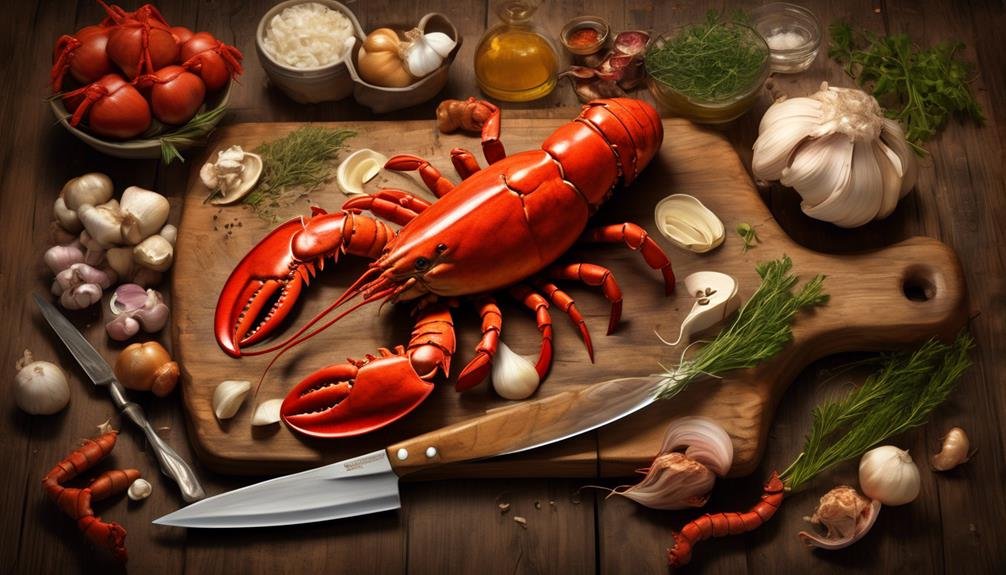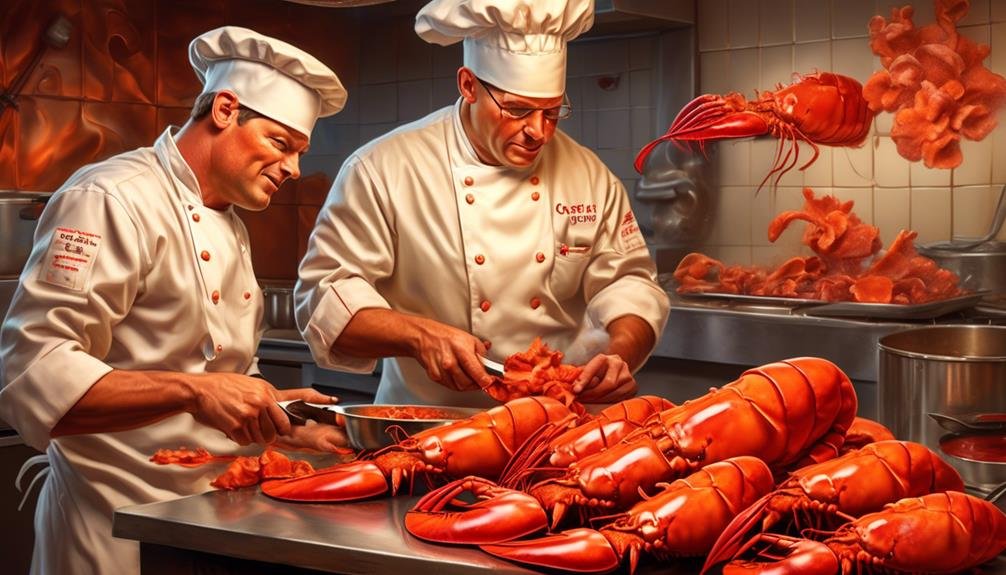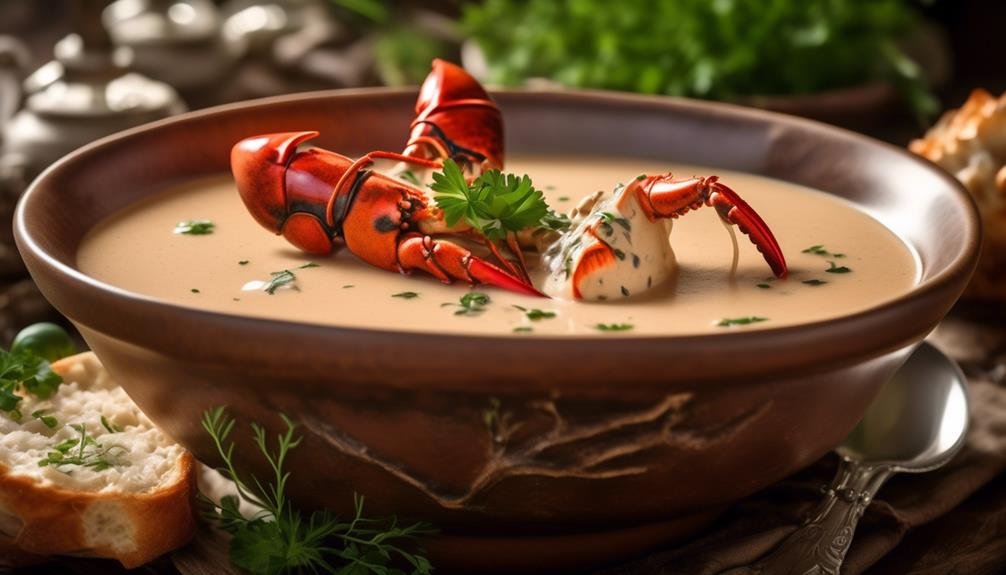Lobster Mushroom Recipes

If you're looking to elevate your culinary repertoire with a touch of the unexpected, lobster mushroom recipes might just be the secret ingredient you've been searching for.
The earthy, umami flavor of these mushrooms adds a delightful depth to a wide range of dishes, making them a versatile and intriguing addition to any kitchen.
But what truly sets them apart?
Keep reading to discover the creative possibilities and mouthwatering recipes that await with these vibrant and unique fungi.
Lobster Mushroom Basics
When preparing lobster mushrooms, ensure you use a dry brush to gently remove dirt and refrain from using a damp cloth to preserve their vibrant coloring.
Lobster mushrooms are a fascinating variety of fungus, known for their vibrant red-orange exterior and firm, meaty texture. They've a distinctive aroma reminiscent of nuts and a subtly sweet flavor.
These unique mushrooms are perfect for adding a pop of color and a delightful umami flavor to your dishes. When cooked, lobster mushrooms release a colorful juice, adding an extra dimension to your culinary creations. They're ideal for pan-frying or sautéing, making them an easy addition to a wide range of recipes. Additionally, their ability to complement seafood dishes makes them a versatile ingredient in the kitchen.
Whether you're an experienced chef or a novice cook, incorporating lobster mushrooms into your recipes is a simple way to elevate the flavor profile of your dishes. With their unique appearance and flavor, lobster mushrooms are a delightful addition to any recipe.
Harvesting and Cleaning Lobster Mushrooms
Transitioning from exploring the vibrant and flavorful nature of lobster mushrooms, let's now delve into the essential processes of harvesting and cleaning these unique fungi.
When harvesting lobster mushrooms, it's essential to look for heavy ones with a vibrant red-orange color, while avoiding light, fishy-smelling, or dark purple ones, which may be too old to eat. To clean fresh lobster mushrooms, use a dry brush to remove dirt and trim any dirty ends. For a thorough clean, wash the mushrooms with cold water and dry them on towels at home. Then, store them in a Ziploc bag with a dry paper towel. When cleaning lobster mushrooms, remember to carve out the middle and any soft tissue using a knife.
If you're using dried lobster mushrooms, make sure to purchase them from reputable sources like local farmers. To clean dried lobster mushrooms, brush off any remaining dirt or debris and rehydrate them by soaking in water.
Harvesting and cleaning lobster mushrooms is crucial to ensure a safe and enjoyable culinary experience.
Cooking Techniques for Lobster Mushrooms

To bring out the best flavors and textures of lobster mushrooms, consider employing various cooking techniques that accentuate their unique qualities.
Pan-frying or sautéing is ideal for these mushrooms, allowing their meaty texture to shine while enhancing their nutty, sweet aroma.
When cooking larger lobster mushrooms, moist methods like braising or steaming can soften their dense texture. To preserve their delicate flavor and aroma, be cautious not to overcook them.
Lobster mushrooms also pair well with seafood, complementing the aroma of dishes containing lobster or crab.
When preparing the mushrooms, use a dry brush to wipe away dirt, avoiding a damp cloth to maintain their vibrant color.
For a flavorful touch, consider cooking lobster mushrooms in a combination of butter and olive oil, which can elevate their natural taste.
If using dried mushrooms, rehydrate them first to ensure they retain their fresh, meaty qualities.
These cooking techniques will help you make the most of lobster mushrooms, bringing out their rich flavor and unique characteristics in your dishes.
Lobster Mushroom Pasta Recipe
Indulge in the rich and savory flavors of lobster mushroom pasta, a delightfully satisfying dish that can be effortlessly prepared for a quick and elegant meal. The vibrant red-orange color and meaty texture of lobster mushrooms bring a unique and delightful element to this pasta dish, making it a standout recipe for any occasion.
Here's how to create this exquisite dish:
- Gather Ingredients: Collect your favorite pasta, lobster mushrooms, garlic, shallots, heavy cream, Parmesan cheese, and fresh herbs such as parsley or thyme.
- Prepare the Lobster Mushrooms: Clean the lobster mushrooms thoroughly and slice them into thin, uniform pieces to ensure even cooking and optimal texture.
- Create the Creamy Sauce: Sauté the garlic and shallots, then add the lobster mushrooms and cook until tender. Pour in the heavy cream and simmer until the sauce thickens. Stir in the Parmesan cheese and fresh herbs for added depth of flavor.
- Combine with Pasta: Toss the cooked pasta in the luscious lobster mushroom sauce until it's thoroughly coated, and serve immediately for a truly indulgent dining experience.
This lobster mushroom pasta recipe promises to elevate your culinary repertoire with its luxurious flavors and vibrant presentation.
Where to Find Lobster Mushrooms

If you're eager to forage for lobster mushrooms, head to mixed woods in the Midwest, Northern Minnesota, and Southern Minnesota. Keep an eye out for large, white mushrooms like Russula brevipes and Lactarius piperatus during your mushroom hunting adventure.
Additionally, specialty grocery stores, farmers markets, and online retailers are great places to find dried lobster mushrooms during late summer and fall.
Foraging for Lobster Mushrooms
When foraging for lobster mushrooms, explore mixed woods with birch, aspen, and red pine to find large, white mushrooms like Russula brevipes and Lactarius piperatus, where these prized fungi often thrive.
To enhance your foraging experience, consider the following:
- Identify the Ideal Habitat: Seek out mixed woods with specific tree varieties such as birch, aspen, and red pine.
- Look for Companion Mushrooms: Lobster mushrooms are often found near Lactarius and Russula mushrooms, so keep an eye out for these varieties as well.
- Check the Weight and Color: Harvest lobster mushrooms that are heavy like a paperweight and have vibrant red colors, avoiding light mushrooms and those with a strong fishy odor.
- Mind the Location: Lobster mushrooms can be found in various regions, including New England. You can also check local farmers' markets for these delectable fungi.
Wild Mushroom Hunting
Exploring mixed woods with birch, aspen, and red pine is a great way to begin your wild mushroom hunting adventure for finding lobster mushrooms. Look for large, white mushrooms like Russula brevipes and Lactarius piperatus, as lobster mushrooms are often found in areas where these mushrooms grow.
In Northern Minnesota, the mixed woods provide an excellent habitat for lobster mushrooms. Additionally, mixed hardwood and oak forests in Southern Minnesota are also promising locations for hunting these prized fungi. The Midwest, in general, is a common place to find lobster mushrooms, especially in mixed woods.
When you find these vibrant mushrooms, consider incorporating them into delicious lobster mushroom recipes. You can freeze lobster mushrooms for later use or sauté sliced lobster mushrooms with freshly ground black pepper and diced potatoes for a delightful dish.
Storing and Rehydrating Lobster Mushrooms
When it comes to lobster mushrooms, proper storage is key to maintaining their freshness and flavor. Ensuring that they're stored in the right conditions will help extend their shelf life and keep them ready for use.
Additionally, understanding the rehydrating process for dried lobster mushrooms is essential for incorporating them into your recipes.
Storage Tips
To maintain the freshness of your fresh lobster mushrooms, store them in a paper bag or wrap them in a damp paper towel. Proper storage can extend the shelf life of fresh lobster mushrooms for up to 5 days in the refrigerator.
When it comes to dried lobster mushrooms, keeping them in an airtight container in a cool, dry place is crucial to preserve their flavor and texture. Rehydrate the dried lobster mushrooms by soaking them in warm water for about 30 minutes before using them in recipes.
Rehydrated lobster mushrooms can be used as an alternative when fresh ones aren't available, ensuring the desired texture and flavor.
Following these storage tips will help you enjoy the delightful flavor and aroma of lobster mushrooms in your cooking.
Rehydrating Process
When rehydrating dried lobster mushrooms, immerse them in warm water for 30 minutes to restore their texture and flavor before incorporating them into your culinary creations. After soaking, strain the mushrooms and pat them dry with a paper towel. Rehydrated lobster mushrooms can serve as an alternative when fresh ones are not available, adding their distinct taste and texture to a range of dishes. To enhance the flavor, consider adding shredded rehydrated lobster mushrooms to pasta dishes with parmesan cheese or using them in soups and stews. Here is a simple guide to the rehydration process:
| Step | Instructions |
|---|---|
| Rehydration Process | Immerse in warm water for 30 minutes |
| Strain | After 30 minutes, strain the mushrooms |
| Pat dry | Pat dry with a paper towel |
| Ready to use | Rehydrated lobster mushrooms are ready for use |
15 Delicious Lobster Mushroom Recipes

Indulge your taste buds with these delectable lobster mushroom recipes that are sure to tantalize your senses and elevate your culinary experience.
- Lobster Mushroom Bisque: Create a velvety bisque by sautéing lobster mushrooms with shallots, garlic, and thyme. Add vegetable or chicken broth, then simmer and puree. Finish with a swirl of heavy cream for a luxurious touch.
- Pan-Seared Lobster Mushrooms: Slice lobster mushrooms and pan-sear them with butter until golden brown. Season with salt and pepper to enhance their natural flavors. Serve as a delightful side dish or as a topping for grilled meats.
- Lobster Mushroom Risotto: Incorporate cooked lobster mushrooms into a creamy risotto for a burst of umami flavor and a pop of red color. Finish with a generous sprinkle of parmesan and garnish with fresh herbs for a stunning presentation.
- Lobster Mushroom Salad: Toss thinly sliced raw lobster mushrooms with a light vinaigrette to highlight their earthy taste. Pair with mixed greens, shaved parmesan, and toasted nuts for a refreshing and delicious salad.
These mouthwatering lobster mushroom recipes are a celebration of their unique flavor and texture, making them an exciting addition to any culinary repertoire.
Frequently Asked Questions
What's the Best Way to Cook a Lobster Mushroom?
For grilled lobster, sautéed mushroom, begin by marinating lobster in garlic and herbs, then sauté lobster mushrooms in butter until golden. Add to risotto for a creamy, earthy flavor. Enhance bisque, pasta, stir fry, pizza, and salad with this versatile ingredient.
What Does a Lobster Mushroom Taste Like?
Imagine biting into a lobster mushroom - its flavor profile is mild, with a subtle hint of shellfish. Its meaty texture makes it perfect for vegan/vegetarian recipes. Popular pairings include fish and steaks, and it can be sautéed for a delightful taste.
Are There Poisonous Lobster Mushroom Look Alikes?
Yes, there are poisonous look-alikes to the lobster mushroom, so it's crucial to be cautious when foraging. Identification tips and mushroom hunting safety are essential to distinguish edible vs. poisonous mushrooms and avoid potential allergic reactions.
What Is the Bacteria in the Lobster Mushroom?
The bacteria in lobster mushrooms is Hypomyces lactifluorum, a parasitic mold. It enhances their taste and texture. Research opportunities exist to explore its nutritional benefits, medicinal properties, and environmental impact. Cultivation methods and culinary uses are also intriguing.

Related Posts